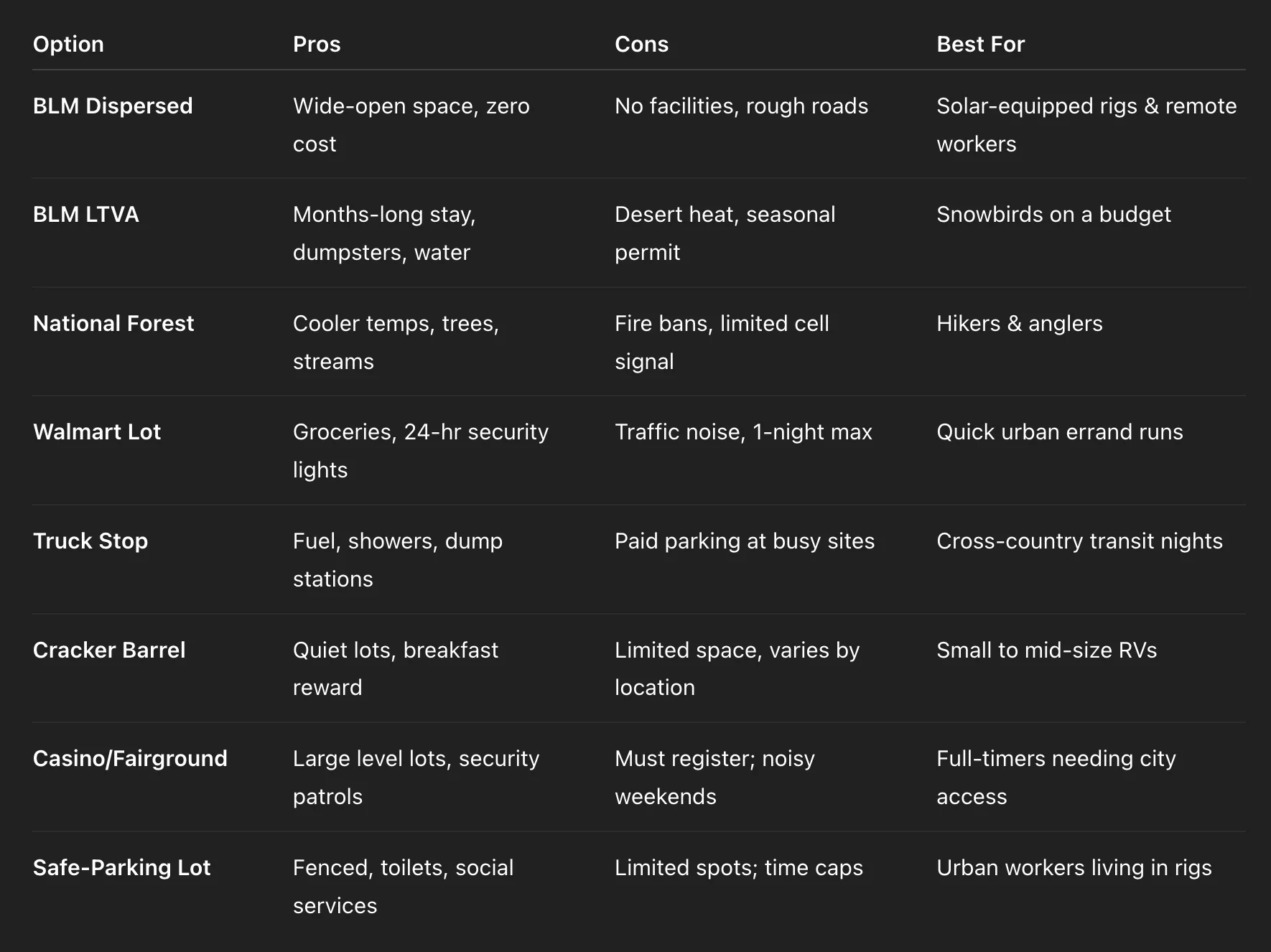Hook & TL;DR — 7 Places You Can Park an RV for $0
✅ Free-stay option
- BLM dispersed land – camp up to 14 days in any 28-day window, then move at least 25 miles
- National Forest dispersed sites – same 14-day guideline; confirm limits at the local ranger district
- BLM Long-Term Visitor Areas (LTVA) – pay one seasonal permit (~US $180) to stay up to 7 months — pennies per night
- Walmart lots – overnight only, with the store manager’s OK and zero “camping” setup
- Cracker Barrel restaurants – most locations welcome RVs after closing; leave at breakfast time and order a meal
- Truck stops (Pilot/Flying J, Love’s) – marked RV lanes, dump stations, Prime-Parking reservations
- Casinos/Fairgrounds – often free if you register with security or player club; rules vary — always ask first (add local examples before publishing).
Know the Legal Ground Rules
Federal agencies (BLM, USFS) set the broad rules on public land; states and counties can tighten them; cities may ban on-street RV habitation altogether.
14-day/28-day rule
On most BLM and National Forest land you may occupy a site for 14 days within any 28-day period, then move to a new area; some field offices shorten or extend that limit, so always check locally.
City ordinances
Many municipalities forbid sleeping in vehicles on public streets. St. Louis, for instance, updated Ordinance 69275 to restrict RV parking in residential areas.
Leave No Trace & etiquette
Pack out trash, keep 200 ft from water, run generators sparingly, and respect posted stay limits. Roadtrippers and Boondocker’s Bible both underline these essentials.
Public Lands You Can Call “Home”
BLM Dispersed Camping
The Bureau of Land Management oversees 245 million acres — about one-tenth of the U.S. land base. These areas are usually road-accessible, free, and governed by the 14-day rule. Confirm additional restrictions with the local BLM field office before settling in.
BLM Long-Term Visitor Areas (LTVA)
Snowbirds flock to eight desert zones in CA/AZ where a single permit (~US $180) covers up to seven months, including trash dumpsters and dump stations — one of the cheapest legal addresses on wheels.
National Forest Dispersed Sites
Most forests mirror the BLM’s 14-day stay cap, but road conditions, fire bans, and travel-management maps differ by ranger district. Check USFS Motor Vehicle Use Maps (MVUM) before you roll in.
Commercial Lots That Still Allow Free Overnights
Walmart — Corporate policy defers to each store manager; ask inside, park at the lot edge, slide-outs in, leave by morning.
Cracker Barrel — Look for the RV/bus lanes behind the building; confirm with staff and be gone before breakfast rush.
Truck Stops — Pilot/Flying J lists RV lanes, potable water, dumps, propane, and reservable Prime-Parking spots.
Casinos & Fairgrounds — Free if you register with security or during off-season events; rules vary widely — call ahead.
Pro Tip: Whatever lot you choose, always ask permission, patronize the business, and leave the space cleaner than you found it.
Urban & Community “Safe-Parking” Programs
Non-profits and cities sometimes designate fenced lots with restrooms so vehicle-dwellers can park legally overnight. San Francisco’s Candlestick Point program, for example, closed in 2024 after high costs and low placement rates, and the city is now debating stricter street bans.
Typical rules: self-contained rigs, quiet hours, proof of insurance, 30-/60-day contracts.
Digital Tools & Communities for Finding Spots
iOverlander — Free, crowd-sourced map of campsites, water taps, dumps, and more; works offline.
BLM & USFS MVUM maps — Official boundaries and route rules.
SpotMyPark filters — Toggle “Free only,” read user reviews, and add new pins; the “Submit a new free site” call-to-action encourages community growth.
Staying Safe & Respectful Long-Term
Security: Park nose-out, use motion lights, share GPS with a friend, and introduce yourself to the nearest ranger or sheriff.
Waste & water: Carry a portable tote for gray/black water, know your closest dump on SpotMyPark or iOverlander, and refill jugs at truck stops or park spigots.
Rotation rhythm: Move before your 14 days expire; overstaying triggers fines and community backlash, threatening future access.
Pros & Cons Snapshot

Conclusion
Free RV living rests on three simple pillars: follow the rules, leave no trace, and keep moving. Respect the 14-day limits on public lands, ask before parking at businesses, and leave every spot cleaner than you found it. Do that consistently and you’ll help keep these free havens open—for yourself and every traveler who comes after you.
